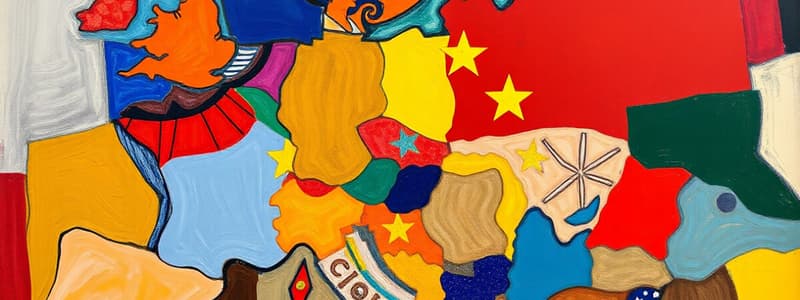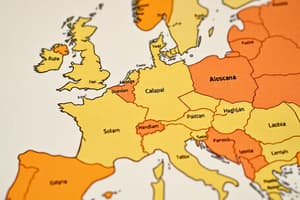Podcast
Questions and Answers
Quel événement a marqué la création de l'Eurozone en 1999 ?
Quel événement a marqué la création de l'Eurozone en 1999 ?
- L'élargissement de l'UE à 27 pays
- L'introduction d'une monnaie partagée et d'une politique monétaire (correct)
- La mise en place d'une commission européenne renforcée
- L'unification des politiques de défense et étrangère
Quels défis majeurs ont été identifiés concernant l'UE aujourd'hui ?
Quels défis majeurs ont été identifiés concernant l'UE aujourd'hui ?
- Un manque de soutien en matière de développement durable
- L'augmentation des disparités économiques entre les États membres (correct)
- La concentration des pouvoirs au sein de la Commission européenne
- L'absence de politiques économiques intégrées
Quelle est l'une des préoccupations principales concernant l'avenir de l'UE ?
Quelle est l'une des préoccupations principales concernant l'avenir de l'UE ?
- L'instauration d'une défense militaire commune
- Le renforcement des identités nationales
- La nécessité d'une gouvernance économique et financière solide (correct)
- L'augmentation du nombre de membres de l'UE
Quel facteur a contribué à rendre complexe la relation entre les identités nationales et l'identité européenne ?
Quel facteur a contribué à rendre complexe la relation entre les identités nationales et l'identité européenne ?
Quels enjeux futurs demeurent centraux pour l'UE ?
Quels enjeux futurs demeurent centraux pour l'UE ?
Quel événement historique a motivé l'idée d'intégration européenne ?
Quel événement historique a motivé l'idée d'intégration européenne ?
Quel traité a créé la Communauté économique européenne (CEE) ?
Quel traité a créé la Communauté économique européenne (CEE) ?
Quel concept souligne l'importance des institutions de l'UE dans le processus d'intégration ?
Quel concept souligne l'importance des institutions de l'UE dans le processus d'intégration ?
Quel acte unique a été essentiel pour la création d'un marché unique ?
Quel acte unique a été essentiel pour la création d'un marché unique ?
Quel traité a officiellement établi l'Union européenne (UE) ?
Quel traité a officiellement établi l'Union européenne (UE) ?
Quel est le principal résultat de la Communauté européenne du charbon et de l'acier (CECA) ?
Quel est le principal résultat de la Communauté européenne du charbon et de l'acier (CECA) ?
Quel cadre théorique soutient que l'intégration économique entraîne une intégration politique ?
Quel cadre théorique soutient que l'intégration économique entraîne une intégration politique ?
Quel était le principal objectif du marché unique de l'UE ?
Quel était le principal objectif du marché unique de l'UE ?
Flashcards
L'eurozone
L'eurozone
La zone euro, créée en 1999, a uni les monnaies et les politiques monétaires de ses membres.
L'élargissement de l'UE
L'élargissement de l'UE
L'élargissement de l'UE a vu son nombre de membres passer de six à vingt-sept, avec des discussions en cours sur de futures expansions.
Défis de l'UE
Défis de l'UE
Des défis tels que le Brexit, les crises économiques et la montée du nationalisme mettent en évidence les interactions complexes entre les facteurs historiques, institutionnels, économiques et sociaux de l'UE.
Critiques envers l'UE
Critiques envers l'UE
Signup and view all the flashcards
L'avenir de l'UE
L'avenir de l'UE
Signup and view all the flashcards
Racines historiques de l'intégration européenne
Racines historiques de l'intégration européenne
Signup and view all the flashcards
Qui était Jean Monnet ?
Qui était Jean Monnet ?
Signup and view all the flashcards
Qu'est-ce que la CECA ?
Qu'est-ce que la CECA ?
Signup and view all the flashcards
Quel était l'objectif du traité de Rome ?
Quel était l'objectif du traité de Rome ?
Signup and view all the flashcards
Quel était l'impact de l'Acte unique européen ?
Quel était l'impact de l'Acte unique européen ?
Signup and view all the flashcards
Qu'est-ce que le traité de Maastricht ?
Qu'est-ce que le traité de Maastricht ?
Signup and view all the flashcards
Qu'est-ce que le fonctionnalisme ?
Qu'est-ce que le fonctionnalisme ?
Signup and view all the flashcards
Qu'est-ce que le néofonctionnalisme ?
Qu'est-ce que le néofonctionnalisme ?
Signup and view all the flashcards
Study Notes
Historical Roots of European Integration
- European integration originated after World War II, driven by a desire for peace and stability.
- Early efforts focused on economic collaboration to prevent future conflicts.
- Key figures like Jean Monnet advocated for supranational institutions to manage shared resources and economies.
- The European Coal and Steel Community (ECSC) launched in 1951, representing the initial step toward a unified Europe. It integrated coal and steel production, fostering economic cooperation among member states.
- The Treaty of Rome (1957) established the European Economic Community (EEC), building on the ECSC and aiming for a common market, eliminating trade barriers between member states.
Key Stages and Treaties
- The Single European Act (1986) advanced integration by prioritizing a single market and charting a course towards a common market by 1992.
- The Maastricht Treaty (1992) formally created the European Union (EU), a broader political entity encompassing monetary union and common foreign policy, along with defining rights for EU citizens.
- The Treaty of Amsterdam (1997) further developed EU institutions and policies, strengthening justice and home affairs.
- The Treaty of Nice (2001) reformed EU institutions to accommodate EU enlargement.
- The Lisbon Treaty (2007) further reformed EU bodies, clarifying jurisdictions and decision-making processes.
Theoretical Frameworks
- Functionalism proposes that economic integration leads to political integration, as shared economic goals engender dependencies and encourage inter-state cooperation.
- Neofunctionalism argues that integration "spills over" from one sector to another, deepening political ties.
- Intergovernmentalism emphasizes national governments' influence in steering integration, with decisions often aligned with national interests.
- Supranationalism highlights the role of EU institutions in driving integration, gaining significant independence from national governments.
Evolution of EU Policies
- The common market evolved into a single market, featuring the free movement of goods, services, capital, and people.
- The EU developed common policies in various sectors—agriculture, environmental protection, and research.
- The establishment of the Eurozone in 1999 was a significant landmark, introducing a shared currency and monetary policy for participating nations.
- Common defense and foreign policies have developed gradually, remaining less unified than economic policies.
- EU enlargement expanded its membership from six initial members to twenty-seven, with ongoing debates about future enlargements.
- Brexit, economic crises, and rising nationalism highlight the complex interplay of historical, institutional, economic, and social factors impacting the EU.
Challenges and Critiques
- Concerns exist regarding EU policies, including bureaucracy and democratic legitimacy.
- Economic disparities among member states and economic shocks/crises have often caused friction and internal pressures.
- The relationship between national and European identities is frequently complex and contested.
Future Directions
- Strengthening the EU's ability to confront global challenges (climate change, migration, geopolitical tensions) are crucial for the EU's future.
- Ongoing debates on EU economic and fiscal governance pose a major concern.
- The EU's capacity to adapt to new challenges and maintain relevance and legitimacy in the face of global uncertainties and shifts is a pressing issue.
Studying That Suits You
Use AI to generate personalized quizzes and flashcards to suit your learning preferences.




